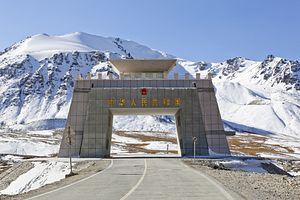In April 2013, China launched Gaofen-1, its first high-definition earth observation satellite (Gaofen-2 was launched just last week, on August 19). This week, China’s National Space Administration reported that Gaofen-1 had captured images showing “dozens of cross-border tunnels” in northwest Xinjiang and along the China-North Korea border. It’s unclear exactly what the tunnels are used for, but Chinese media tied their existence to previous reports on illegal China-North Korea border crossings, as well as reports that Uyghur militant and terrorist groups often travel to foreign countries for training.
For China, the cross-border tunnels in Xinjiang are likely to be of more concern. The East Turkestan Islamic Movement (ETIM) and its offshoot, the Turkestan Islamic Party (TIP), both have bases in the tribal regions of Pakistan. The groups are believed to train with other militant groups from around the region, including al-Qaeda and the Islamic Movement of Uzbekistan (which claimed responsibility for the June attack on Karachi’s international airport). China is quite concerned about this international training, as it leads to increasing sophistication on the part of ETIM and TIP as well as potentially converting other Muslim militants to the Uyghur cause. However, China’s major concern is that militants trained abroad will then sneak back into China to carry out terrorist attacks. That makes the tunnels a potential threat.
The brief reports in the Chinese media did not specify where the cross-border tunnels led. Xinjiang borders a number of different countries, including Kazakhstan, Kyrgyzstan, Tajikistan, Afghanistan, and Pakistan. The description of the tunnels as being located in northwest Xinjiang, though, hints that they might connect western China with Kazakhstan and Kyrgyzstan. That in turn suggests a more benign explanation for the cross-border tunnels: they may be used by would-be Uyghur refugees rather than militants.
The Chinese government restricts the ability of Xinjiang’s Uyghurs to travel abroad, meaning those who wish to emigrate often leave the country illegally. The Chinese government has long tried to crack down on Uyghur émigrés, including demanding that refugees who arrive in other countries be forcibly returned to China. Central Asian countries like Kazakhstan are prime locations for Uyghur refugees, both because of their geographical location and because they are already home to Uyghur ethnic enclaves.
The North Korean border tunnels may represent a similar phenomenon, but in reverse. North Koreans often try to sneak across the Chinese border, looking to start a new life either in China or elsewhere. The reported tunnels may have been used by North Koreans seeking illegal passage into northeast China. The Chinese government regularly repatriates these refugees, despite outcry from human rights groups. The recent UN commissioned report on North Korea’s human rights situation estimated that Beijing has repatriated tens of thousands of North Koreans, almost all of whom then faced punishments ranging from imprisonment and torture to execution.
However, as my colleague Zach noted recently, North Korea is also a large supplier of illegal drugs, especially synthetic drugs. It’s possible that the China-North Korea tunnels could be used for smuggling, whether drugs or other contraband (including technological items like smartphones that are freely available in China but tightly controlled by Pyongyang).
The news about the cross-border tunnels in Xinjiang and northeastern China comes just as China’s legislators are seeking an increased focus on counterespionage activities within China. The announcement that the Gaofen-1 satellite had provided information on illegal cross-border tunnels (among other, unspecified “massive information”) to China’s public security departments is good publicity for both China’s technology and the country’s national security apparatus.

































